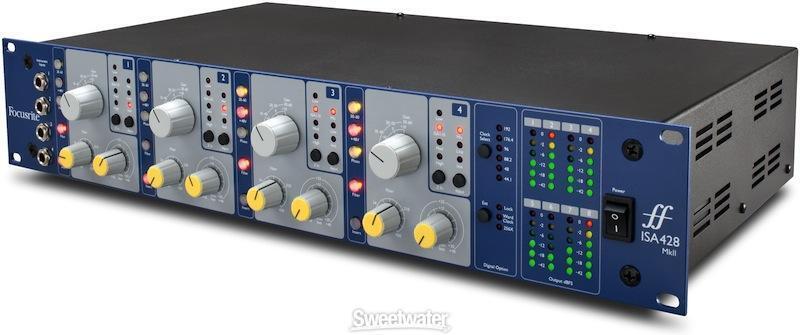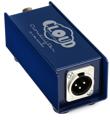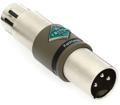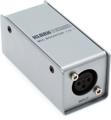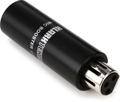How to Choose a Mic Preamp
Along with the musician and the microphone, your choice of microphone preamplifier will play a significant role in the final sound of your productions. And while the basic purpose of a mic preamp is utilitarian (boosting a low-level mic or instrument-level signal up to line level), there are many other things you’ll want to look for in a mic preamp to get the most out of your microphone or instrument collection.
This Mic Preamp Buying Guide will help narrow your choices and help you find the ideal mic preamp for your needs. As always, a call to one of our expert Sales Engineers at (800) 222-4700 will get you the answers to help you choose the best mic preamp for your needs and budget.
When shopping for a new mic preamp, the important thing to remember is that your preamp is another link in a chain — consider all the different ways you’d like to be able to connect to your existing gear before deciding on a mic preamp. Here’s what to look for.
- Inputs and Outputs “
- Tube Preamp vs. Solid State Preamp “
- Hybrid Mic Preamps “
- Form Factor: Rackmount, 500 Series, or Desktop “
- Single channel, Dual channel, or Multichannel Mic Preamp? “
- Channel Strips: Mic Preamplification and Processing in One Box “
- Additional Mic Preamp Features to Consider “
- Mic Preamps: What to Look For “
Inputs and Outputs
Any microphone preamplifier will have at least one microphone input and one line level output. That will get the job done, but you may want more functionality out of your mic preamp. Some mic preamps have a hi-Z Direct Input (DI) on them as well to record guitar, bass, and other electric instruments directly — look for this input if you record electric instruments often, even if you usually just mic up an amplifier.

Some mic preamps have more than one output — it’s not uncommon to see an XLR output and a 1/4″ TRS output on the same mic preamp to give you more connectivity options, for instance. Mic preamps with multiple outputs will sometimes allow you to use the preamp as a signal splitter: you could run one line-level output to your recording interface and another to a compressor or EQ for processing before recording. Depending on how you prefer to run your sessions, having a mic preamp with multiple outputs may be a huge help.
Some microphone preamps have a built-in A/D converter, which allows you to run a digital signal out of the mic preamp directly to your recording device. You’ll typically achieve a lower noise floor than you would with an analog connection, and it’s also a great way to take advantage of an unused digital input on your interface while saving an analog input for a different application. To learn more about mic preamps and why you need one, visit our blog, What Is a Preamp, and Do I Need One?
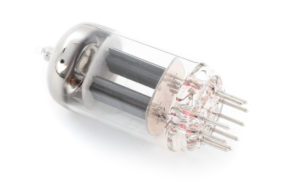
Tube Preamp vs. Solid State Preamp
Does your recording call for the lush, euphonic sound that tube saturation can provide, or the crisp punch and clarity of a good solid state design? Only you can decide, which is why it’s invaluable to equip your studio with a variety of outstanding mic preamplifiers with different sonic signatures (including at least one with as little “character” as possible). Commercial studios offer their clients an assortment of both tube and solid-state preamps. If you’re just beginning to outfit your personal studio and won’t be tracking a band, we’d recommend starting with one of each.
Hybrid Mic Preamps

Some mic preamps contain both a tube path and a solid-state circuit, with the option of selecting either — or even a combination of the two. You might consider one of these if your recording content is equally divided, for example, between vocals and instruments, or between guitars and keyboards.
Form Factor
Rackmount, 500 Series, or Desktop

Mic preamps come in three basic packages: standard 19″ rackmount, 500 Series module, or as a desktop unit. Some manufacturers make their more popular mic preamp units available in multiple form factors, say, rackmount and 500 Series. Form follows function, so you want to configure your studio space to ensure that it’s ergonomically set up to aid your workflow and creativity (and help you avoid repetitive strain injuries).
Shop for 500 Series Mic Preamps “
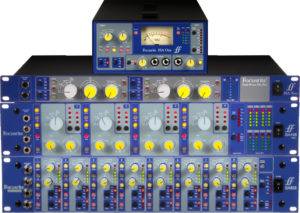
Channels
Single, Dual, or Multichannel Mic Preamp?
If you’re growing your studio, you’ll definitely want to look at multichannel mic preamps in addition to single- and dual-channel mic preamps. Even if you don’t currently record with more than two mics at a time, that may likely change in the future. And there’s investment value to consider too: compare the per-channel cost of a high-end, multichannel mic preamp to a single- or dual-channel preamp. Sometimes, you’ll actually be paying less per channel for a higher quality preamp. While the initial investment will be higher, you’ll be glad you made it when you start working on larger projects and don’t have to invest in more mic preamps.
Shop for Single-channel Mic Preamps “Shop for 2-channel Mic Preamps “Shop for Multi-channel Mic Preamps “
Channel Strips
Mic Preamp and Processing in One Box
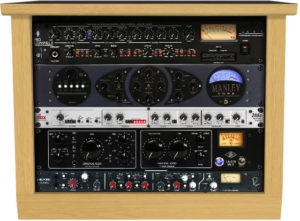
A channel strip comprises a number of signal processing tools starting with a preamp, usually followed by a compressor, EQ section, and in some cases a de-esser or enhancer (exciter). If you’re recording vocals, for example, this gives you every processing tool you need for professional vocal recording in one convenient and cost-effective unit. Since all the electronics are housed inside the same box (as opposed to being patched from a distinct preamp to compressor to EQ, etc.), the chances for noise are diminished.
If you only use one or two microphones at a time, such as in voice over or radio broadcast applications, a couple of channel strips could serve you much better than working with separate preamps and processors. It can simplify your signal flow, you’ll get great results, and you won’t have to manage multiple pieces of gear to get the sound you want.
Additional Mic Preamp Features to Consider
Beyond the ubiquitous gain control, some mic preamps have additional controls and functions that may be helpful in a recording session. One common feature you’ll see is a low-cut (also called highpass) filter, usually at 150Hz or below. This is a great way to cut out low-end rumble that you don’t want in vocal or acoustic instrument tracks. Especially if your microphones don’t have a low cut filter, you’ll definitely appreciate having access to one on your preamp during tracking. You’ll capture a cleaner sound, and you’ll save headroom by removing unwanted bass.
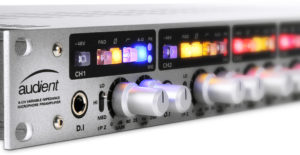
Some mic preamps give you the option of switching a transformer in and out of the signal path. Adding a transformer to the signal path often adds a distinctive vintage character to a recording, which may or may not be desirable. If you want a mic preamp that can give you both transparent and colored sonic results, you might look for a preamp with a switchable transformer. If you know you’ll always want some character from your mic preamp, look for one that has a transformer in the signal path. If you want a mic preamp that is as clean as possible, looking for one that is transformerless is a good place to start. The sound of a mic preamp doesn’t begin and end with a transformer (though some do have input and output transformers), but it plays a significant role.
One more thing to consider is stereo recording: some dual-channel mic preamps have a stereo mode that allows you to adjust the gain equally across both channels with just one knob, making it easier to record a balanced stereo signal from two mics. Some mic preamps even have a built-in M/S matrix to help you record with the mid-side stereo technique. If you record in stereo often, you’ll definitely want to keep an eye out for dual-channel preamps with channel-linking capabilities.
Mic Preamps: What to Look For
In summary, there are a few things you should ask yourself when searching for a microphone preamplifier:
- What will you be connecting the mic preamp to and how will it fit into your existing workflow?
- How many channels of preamplification do you need?
- Do you want additional sound-shaping controls on the mic preamp, or just mic gain?
- Would a channel strip with built-in compression and EQ be a more efficient way to get the sound you want while recording?
Visit our blog, The 8 Best Mic Preamps for Recording, to learn more about some of the best mic preamps available.
You’ll notice that so far we haven’t even talked about specific applications for mic preamps: drums, acoustic guitar, vocals, and so on. That’s because if you ask 10 expert audio engineers what their favorite preamp is for any given application, you’ll get at least 10 different answers. Looking at the big picture, it’s important that you get a preamp that integrates well with your workflow, has the amount of sonic control you want, and basically supports your day-to-day recording habits.


